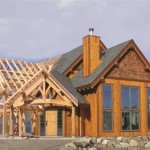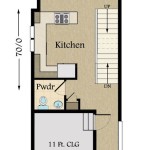Small Modular Home Floor Plans: Maximizing Space and Efficiency
Small modular homes represent a growing trend in the housing market, offering an alternative to traditional site-built construction. These homes are built in a factory-controlled environment in sections, or modules, and then transported to the building site for assembly. The appeal lies in their potential for cost savings, faster construction times, and increasingly, their customizable nature. A crucial aspect of designing a small modular home is the floor plan, which dictates the layout, functionality, and overall livability of the space. Careful consideration of floor plan options is essential to create a comfortable and efficient dwelling.
When considering small modular home floor plans, it's vital to understand the limitations and advantages they present. Space is a premium, demanding innovative design solutions to maximize every square foot. Multifunctional spaces, clever storage solutions, and thoughtful placement of furniture become paramount. Conversely, the modular construction process can offer greater control over the interior layout compared to some site-built options, allowing for tailored solutions to specific needs and lifestyle requirements. The inherent design flexibility of modular construction allows homeowners to prioritize specific features or accommodate future expansions.
Understanding Square Footage and Layout Options
The definition of a "small" modular home can vary, but generally, it encompasses homes under 1,000 square feet. Within this range, diverse floor plans can be effectively utilized. Common layouts include studio apartments, one-bedroom cottages, and compact two-bedroom designs. The selection of a floor plan significantly influences the perceived spaciousness and practicality of the home. A well-designed layout can make a small space feel larger and more accessible, while a poorly designed one can feel cramped and disorganized.
Open-concept layouts are frequently employed in small modular homes to create a sense of spaciousness and flow. Combining the living room, dining area, and kitchen into a single, unified space eliminates walls and maximizes natural light penetration. This approach can be particularly effective in smaller homes, as it avoids the feeling of being boxed in by separate rooms. However, careful consideration must be given to furniture placement and zoning within the open space to define distinct areas and prevent the space from feeling chaotic.
Conversely, some homeowners prefer more compartmentalized layouts, even in small spaces. Separating the living area from the bedroom, for instance, can provide increased privacy and a greater sense of personal space. This approach may involve strategically placed walls, partitions, or built-in storage to divide the rooms effectively. The choice between an open-concept and a compartmentalized layout ultimately depends on the homeowner's personal preferences and lifestyle.
Beyond the basic layout, the orientation of the home on the lot also plays a critical role in the overall functionality and comfort. Optimizing the home's orientation to maximize natural light, views, and privacy can significantly enhance the living experience. Strategic placement of windows and doors can capture sunlight during the day and create a connection to the surrounding landscape. Careful consideration of these factors can transform a simple floor plan into a welcoming and enjoyable living space.
Key Considerations for Small Modular Home Design
Designing a small modular home floor plan requires a strategic approach that addresses the unique challenges and opportunities presented by limited space. Several key considerations should guide the design process to ensure a functional, comfortable, and aesthetically pleasing living environment.
Storage:
Adequate storage is crucial in any small home, but especially in modular designs where maximizing every square foot is paramount. Integrating smart storage solutions throughout the floor plan can significantly improve the organization and livability of the space. Built-in shelving, under-bed storage, and multi-purpose furniture can help to minimize clutter and maximize usable space. Vertical storage, such as floor-to-ceiling cabinets or tall bookcases, can also be employed to make the most of limited floor area.Multifunctional Spaces:
Designing spaces that can serve multiple purposes is another effective strategy for maximizing space in a small modular home. A guest bedroom that doubles as a home office, a dining table that folds away when not in use, or a living room with a convertible sofa bed are all examples of multifunctional design. These types of spaces can adapt to changing needs and provide flexibility throughout the day.Efficient Kitchen and Bathroom Design:
Kitchens and bathrooms often require significant floor space, which can be challenging in a small home. Optimizing the layout and functionality of these spaces is therefore essential. Compact appliances, such as smaller refrigerators and dishwashers, can save valuable space. Wall-mounted sinks and toilets can also free up floor area and create a more open feel. Careful consideration of the workflow and storage needs in these spaces is crucial to ensure they are both functional and efficient.Natural Light and Ventilation:
Maximizing natural light and ventilation is important for creating a healthy and comfortable living environment in a small modular home. Large windows can bring in natural light and create a sense of spaciousness. Skylights can also be used to bring light into areas that may not have access to windows. Proper ventilation is equally important for maintaining air quality and preventing moisture buildup. Cross-ventilation, achieved by strategically placing windows and doors, can help to circulate air throughout the home.Accessibility:
Although not always a priority for every homeowner, considering accessibility during the design process can improve the long-term usability of the home. Wider doorways, zero-threshold showers, and grab bars can make the home more accessible to people of all ages and abilities. Incorporating these features during the initial design phase can be significantly easier and more cost-effective than retrofitting them later.Specific Floor Plan Examples and Considerations
Several popular small modular home floor plans cater to different needs and lifestyles. Understanding the characteristics of each type can help in selecting the most appropriate design for a given situation.
Studio Apartment:
A studio apartment typically combines the living, sleeping, and kitchen areas into a single open space. This layout is ideal for individuals or couples seeking a minimalist living environment. Effective space planning is critical in a studio apartment to define distinct zones and prevent the space from feeling cluttered. Creative storage solutions and multifunctional furniture are essential for maximizing the functionality of the space. The bathroom is usually separated from the main living area for privacy.One-Bedroom Cottage:
A one-bedroom cottage provides a separate bedroom in addition to the living and kitchen areas. This layout offers more privacy and separation than a studio apartment. The bedroom is typically located at one end of the home, providing a quiet retreat. The living and kitchen areas are often combined into an open-concept space to maximize the sense of spaciousness. A well-designed one-bedroom cottage can be a comfortable and functional home for individuals or couples.Two-Bedroom Design:
Two-bedroom modular homes, although pushing the upper limit of what is considered “small,” are popular among small families, or those who require a guest room or home office. This floor plan usually features a common living space with kitchen, dining, and gathering sections. The bedrooms are often placed on opposite sides of the home to maximize privacy. Clever storage strategies are paramount to making use of all available space, and careful consideration of the flow between rooms is essential for comfortable living.Accessory Dwelling Units (ADUs):
ADUs, often called "granny flats" or "in-law suites," are self-contained living units located on the same property as a primary residence. Small modular homes are often used as ADUs and are subject to local zoning regulations and building codes. ADUs can be used for a variety of purposes, such as housing family members, renting out to tenants, or providing a home office. The floor plan of an ADU typically includes a living area, kitchen, bedroom, and bathroom, although layouts can vary considerably based on the intended use.When selecting a specific floor plan, it is important to consider personal needs and lifestyles, as well as the specific requirements of the building site. Factors such as the size of the lot, the local building codes, and the desired level of privacy should all be taken into account. Working with a qualified architect or modular home builder can help to ensure that the chosen floor plan meets all requirements and provides a comfortable and functional living environment.
Ultimately, the choice of a small modular home floor plan depends on individual wants and needs. By carefully considering square footage, layout options, design considerations, and specific floor plan examples, potential homeowners can make informed decisions that lead to a comfortable and efficient small living space. The modular approach allows for modification of standard plans, tailoring the home to the user rather than the user adapting to a pre-existing structure. This inherent flexibility is one of the greatest assets of modular home construction.

Floor Plans Cvs 3242k1 0 Manufactured And Modular Homes In 2024 Home House Plan With Loft Small

Small Modular Home 805 Sq Ft Kintner Builder Pennsylvania Quality Prefab Contractor Tiny Living

The Pennflex Ii Ranch Modular Home Series Standard As Style Pennwest Homes Model Hr170 A Custom Built By Patriot S

Floor Plans Lincoln Manufactured And Modular Homes Tiny House Small

Modular Homes Floor Plan Model 9561

Floor Plans Austin Tx Modular Homes

Custom Modular Homes Home Builder Renovations

Ranch Floor Plans Kintner Modular Home Builder Pennsylvania Quality Prefab Contractor

Modular Floor Plans Sunrise Housing

Modular Home Designs Can Be Made Wider Longer








